If you want a unique flowering plant that can add a tropical feel to your backyard, consider growing the Mandevilla vine.
It’s a beautiful, annual climber that can survive many seasons if you overwinter it properly. You can grow Mandevilla in hanging baskets or train them to climb a structure.
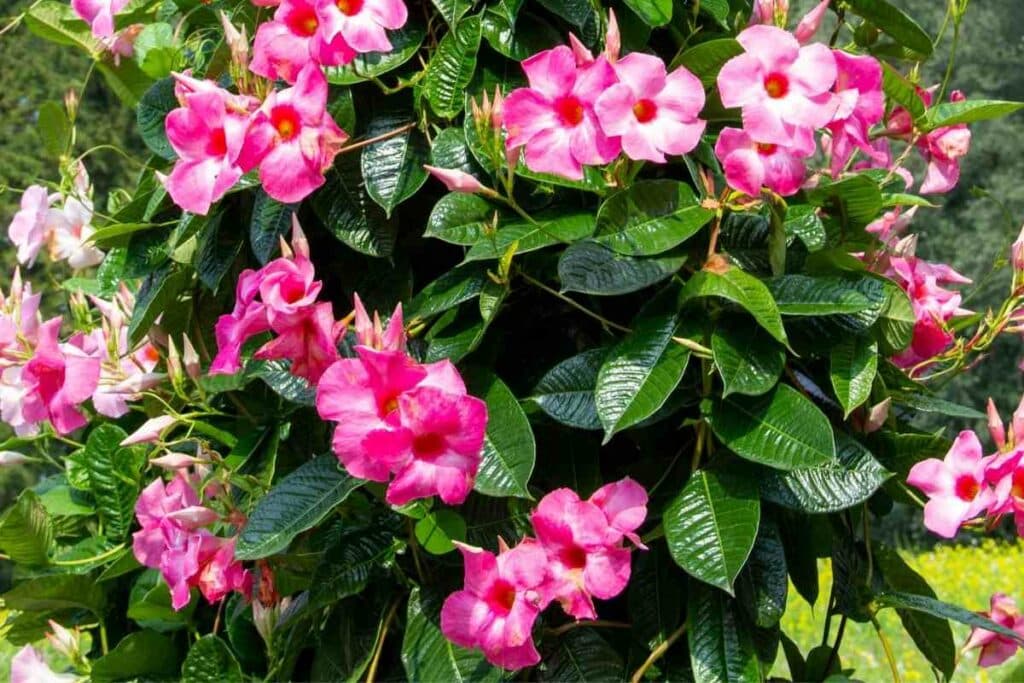
Mandevilla – Also called rock trumpet, is a genus of flowering plants from Central and Northern South America. Since it’s native to tropical climates, it cannot withstand temperatures below 50oF.
How to Grow Mandevilla
Mandevilla vines thrive in tropical climates with a lot of sunlight, rain, and well-draining soil. Here are some useful tips on growing it at home.
Sunlight Requirements
If you want your Mandevilla vines to produce big, beautiful blooms, grow them in an area that receives abundant indirect sunlight.
Although plants can withstand direct sunlight, they grow faster in shaded areas.
However, if the plant doesn’t receive adequate sunshine as it matures, it will likely have stunted growth.
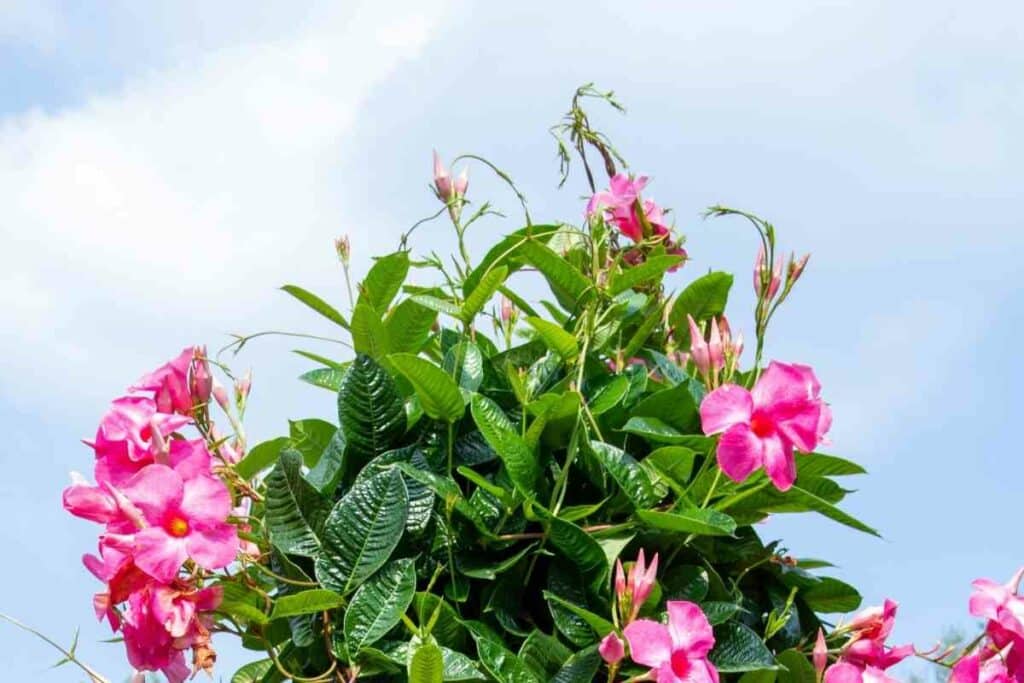
It’s advisable to plant your Mandevilla in a location that receives direct sunlight in the morning but has some shade at midday when the sun is at its peak.
This enhances the plant’s development and blooming. You must also support the vines to prevent damage caused by strong winds.
Watering and Drainage
Regarding water, the Mandevilla grows best in moist, well-draining soils.
Therefore, letting the soil dry before re-watering the plant is essential.
Also, slow-release drip irrigation is the best way to maintain consistent moisture levels and avoid overwatering.
Keep In Mind – You must ensure that your Mandevilla vines grow on well-draining soil. If the surface has poor drainage, the ground becomes soggy, increasing the risk of root rot.
This dangerous condition causes severe damage and eventually kills the plant.
When watering, spray some on the leaves to remove dust and debris.

When you overwater Mandevilla plants, you might start noticing fungal growth.
This happens when the soil is soggy or the plants lack proper ventilation, causing the proliferation of powdery mildew. Ensure the ground is dry before the next watering interval.
Nutritional and Soil Requirements
Mandevilla vines grow well in nitrogen and calcium-rich soils.
Nitrogen supports vegetative growth, while calcium is vital in forming cell walls and membranes.
For this reason, you must provide the potting mix or substrate to grow this plant indoors or apply fertilizers outdoors.
The best soil to grow Mandevilla on is loose loam. If you can’t find this, use a compost potting mix.
However, you should add a layer of gravel at the planter’s base to improve drainage. Adding a little perlite to the mixture enhances water retention.
Overwintering Your Mandevilla
Mandevilla is a fairly hardy plant that can withstand mild winters.
However, it’s worth noting that the plant won’t grow during this period, as it will use its nutrients to survive the cold.
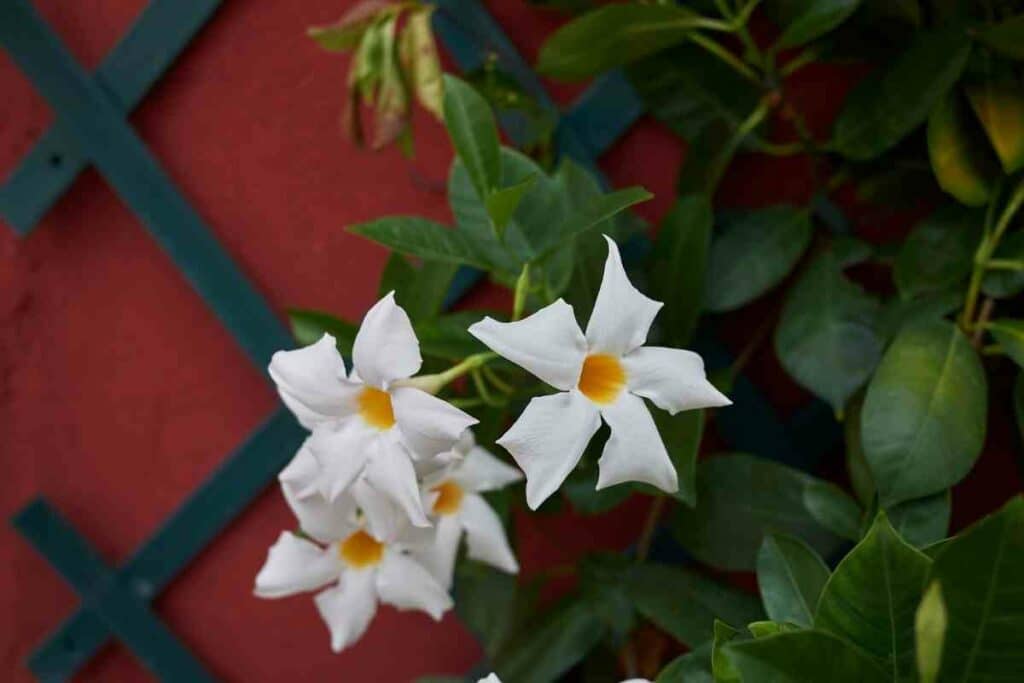
In regions that experience harsh winters with frosts, the upper part of the plant dies. However, the roots survive, allowing the plant to regrow in spring.
Unfortunately, Mandevilla vines cannot survive extreme winters, where temperatures consistently remain at -10 degrees Celsius.
If you live in such climates, bringing the growing pot indoors is best until outdoor conditions improve.
Another challenge that Mandevilla vines face during winter is vulnerability to pest infestations.
Before overwintering your plant, check for:
- adult pests
- larvae
- and eggs
If present, prune the plant to remove the affected parts and prevent spreading. For severe infestations, spray the plant with neem oil to kill the parasites.
Neem oil is an organic pest control mechanism that kills the parasites infesting your Mandevilla vines.
Although it’s safe to use, it is harmful when ingested. Therefore, it’s best to keep it away from children’s reach.
Benefits of Growing Mandevilla
Here are the top reasons to grow Mandevilla vines in your garden.
1. Create Vertical Interest with Vines
If you’re keen on outdoor living trends, you might have noticed that more homeowners are adding vertical interest to their yards by growing climbing plants.
Mandevilla is ideal for creating this interest and beauty through its stunning flowers blooming every spring.
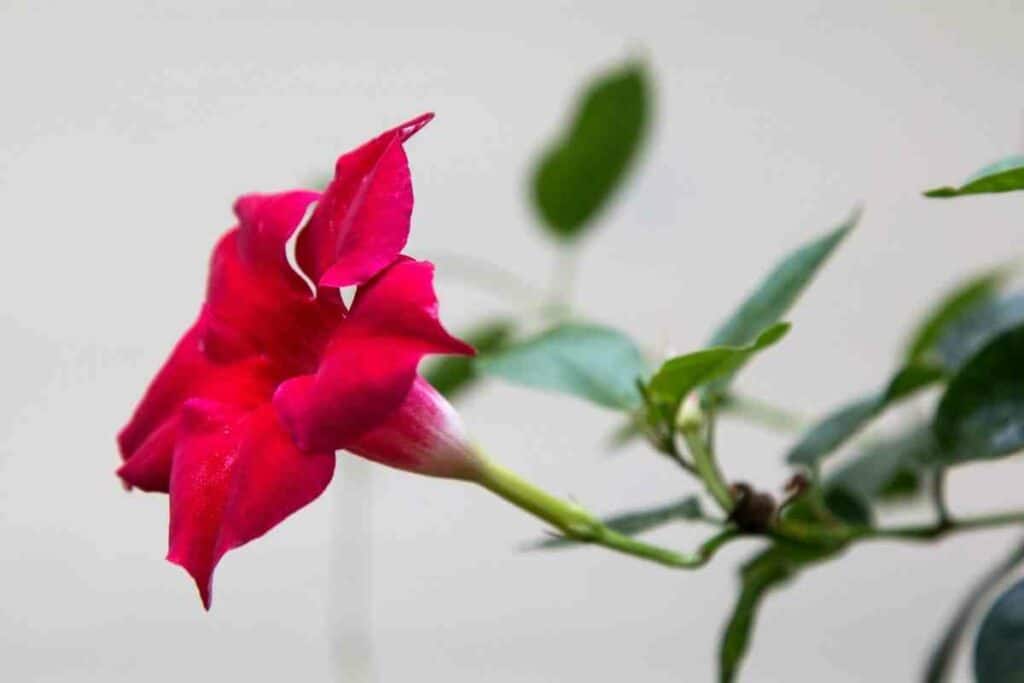
You can train your Mandevilla plants to climb fences, trellises, and other outdoor structures, beautifying them with their dense green foliage and colorful blooms.
The lush greenery is particularly useful if you want to add privacy to your outdoor spaces, while the vibrant flowers add a splash of color.
2. Some Varieties Thrive in Small Spaces
Finding the right decoration for a small backyard can be quite challenging.
Many homeowners get it wrong by purchasing large elements that overwhelm the space or installing tiny decorations that go unnoticed.
You can solve this by growing mounding varieties of the Mandevilla plant.
Mounding Mandevilla plants don’t climb – instead, they produce tiny mounds with striking colors.
What to Expect? They grow to 18 inches in height and width, making them perfect for hanging gardens and small flower beds. You can also grow them indoors.
3. Easy to Grow
Unlike most flowering plants that wilt under heat, Mandevilla plants thrive in it.
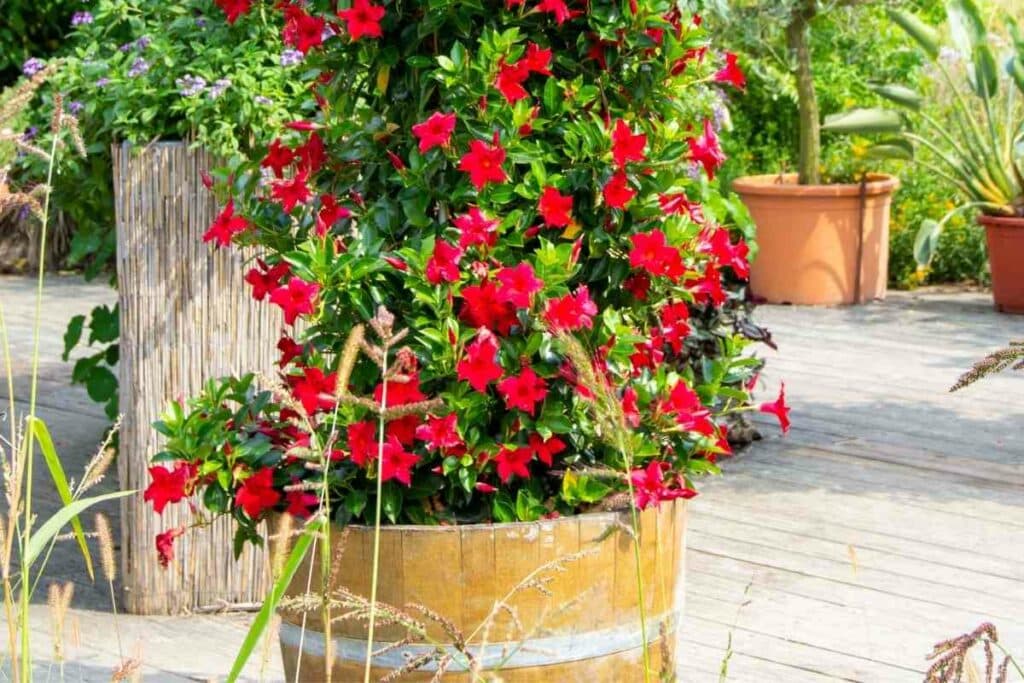
They are indigenous to tropical and subtropical climates and can easily survive high summer temperatures.
They grow well in hot spots like brick planters and terracotta pots on the south- or west-facing walls.
Since they originate from the tropics, Mandevilla plants can only withstand mild winters.
When it’s freezing and frosting, they deteriorate and can die. The good thing is that you can bring them indoors until outdoor conditions improve.
As mentioned earlier, Mandevilla plants don’t bloom during winter because they lack sunlight.
If your area receives a little sun in winter, place them next to a window to promote healthy growth.
4. They Attract Pollinators
Mandevilla flowers produce thick, sugary nectar that attracts pollinators like bees, butterflies, and hummingbirds.

Growing these plants contributes positively to the ecosystem by providing food to these pollinators.
But, more importantly, the butterflies and hummingbirds beautify your backyard, making it more enjoyable to spend time outdoors.
5. Deer and Rabbits Don’t Eat Mandevilla
One of the most significant nuisances of living in rural areas is frequent critter attacks on your outdoor gardens.
Rabbits and deer are notorious for destroying beautiful flowers by eating their leaves and damaging the blooms.
However, Mandevilla plants are immune to such attacks.
Mandevilla leaves and stems have a thick, milky sap with an unpleasant taste.
It’s also toxic, a trait found in other plants in its family, such as:
- Amsonia
- desert rose
- oleander
- plumeria
- and vinca
FAQs About Mandevilla Plants
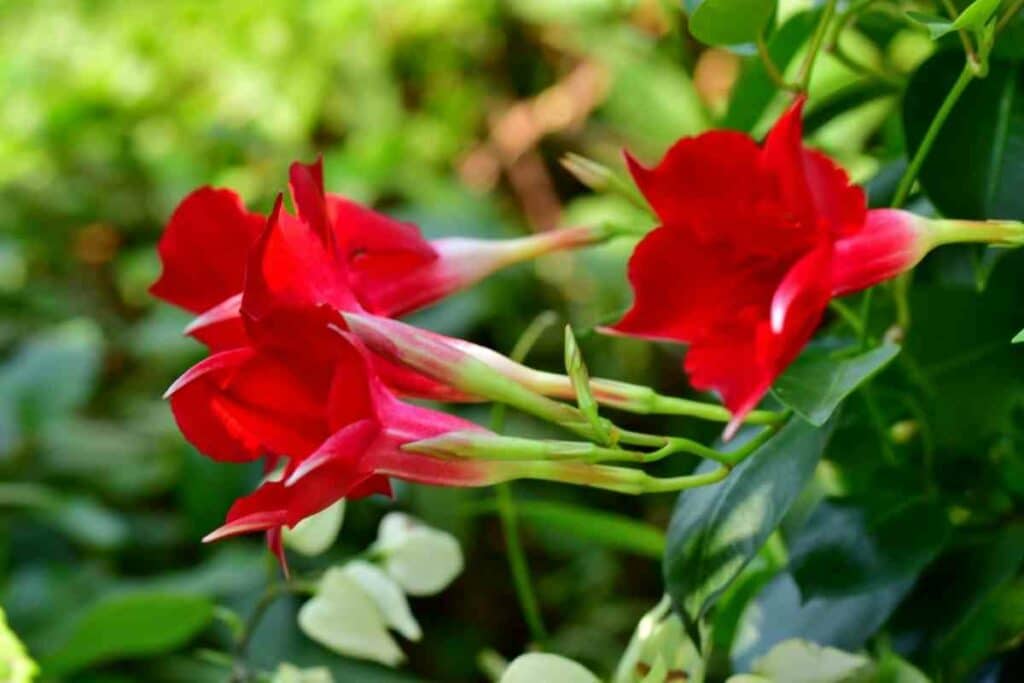
1. How long is the Mandevilla bloom period?
The Mandevilla blooming season is from late spring through summer to the first frost in autumn. Generally, the higher the temperatures, the more flowers it produces.
2. Is Mandevilla poisonous?
When planting, be careful because Mandevilla contains a toxic milky sap. It causes stomach upsets when ingested, so it’s best to keep it away from pets and kids. The juice can also irritate the skin.
3. Do pests affect Mandevilla?
The milky sap doesn’t keep pests away. Instead, pests cause diseases that cause yellowing and reduced flowering. If this happens, prune the affected parts to prevent spreading.
Wrapping Up
Although it’s native to the tropics, the Mandevilla plant thrives in other parts of the world if you provide the conditions.
To ensure it flourishes throughout the year, bring it indoors during winter.
You can also grow it inside the house full-time, as it doesn’t exceed eight feet tall.


